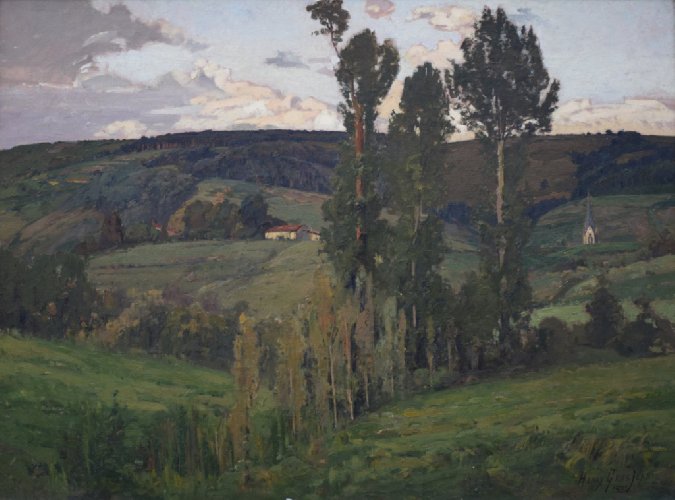Description:
Henry (Marie-Gustave-Henri) Grosjean (1864-1948) was a French landscape painter born in Gondrecourt-le-Château in the Meuse department on the border of Lorraine and the Grand Est region. From 1885 to 1892 he was a student at the École des Beaux-Arts in Paris, and from 1889 to 1894 at the Académie Julian. His teachers were Gustave Boulanger, Jules Lefebvre, Tony Robert-Fleury and possibly Jean-Joseph Benjamin-Constant. From 1892 he exhibited at the Société des Artistes Français Salon, and from 1905 also at the Autumn Salon. He was a member of the association “L’Éclectique” and a knight of the Legion of Honor.
The painting description:
In 1902 the artist married Cécile Chochod from Coligny, a small town in the Ain department in the Auvergne-Rhône-Alpes region. From that moment the region became his favorite theme for his paintings, which he painted in different seasons. Examples are the already mentioned “Late Snows” and the second canvas from the Rogalin Gallery, which shows Coligny and its surroundings.
The artist takes us to a small hill, which he may have reached with his donkey Pandora. Together with him we look into the depths of the vast valley enclosed by the opposite slope covered with forest. The mosaic of meadows bent in different directions is separated by darker hedges and groves. The most pronounced depression begins in the lower left corner and runs diagonally to the center of the painting, connecting with another. From it rises a row of delicate trees with light olive-green shades and a triad of tall poplars with dark crowns, which clearly distinguish from the cloudy sky. This strong vertical dominance is complemented by the slender tower of the church, emerging from the next depression. The white of its walls corresponds to the sandy facade of the low house in the center of the composition, which is the only stronger color accent in this subdued play of various greens and milky-steel blues of the sky. The careful observation of chromatic relations was supplemented by the soft, synthesizing way of painting the vegetation of the meadows and clouds in combination with the rough, more detailed characterization of the trees and shrubs. Thus, giving the mood of a peaceful day in this nature-oriented small town, he noted at the same time the trembling of the leaves moved by the invisible breath of the wind.


